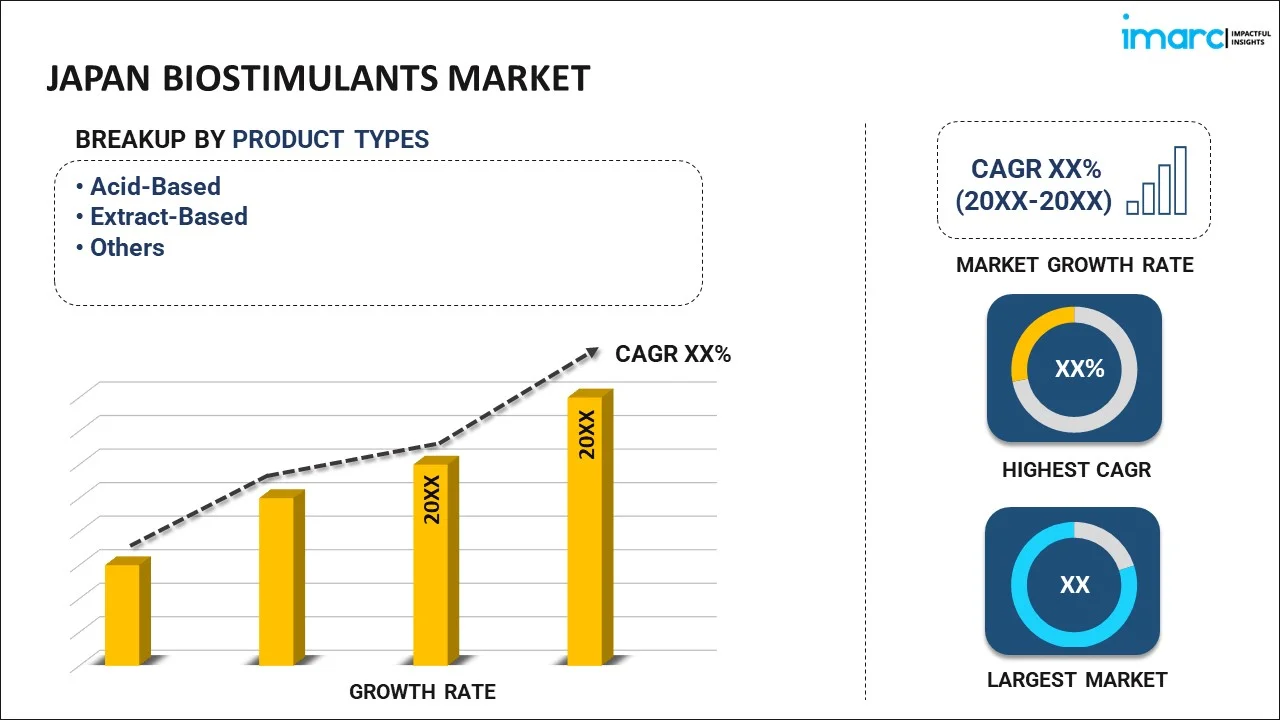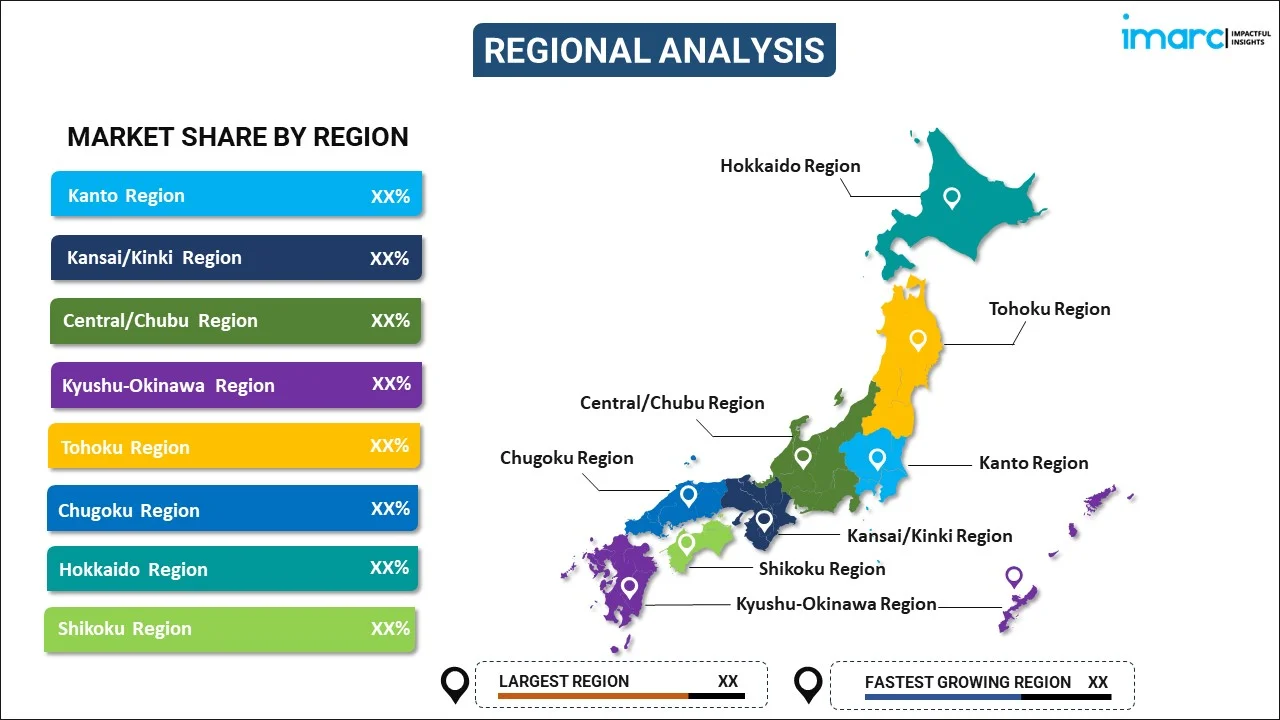
Japan Biostimulants Market Report by Product Type (Acid-Based, Extract-Based, and Others), Crop Type (Cereals and Grains, Fruits and Vegetables, Turf and Ornamentals, Oilseeds and Pulses, and Others), Form (Dry, Liquid), Origin (Natural, Synthetic), Distribution Channel (Direct, Indirect), Application (Foliar Treatment, Soil Treatment, Seed Treatment), End User (Farmers, Research Organizations, and Others), and Region 2025-2033
Market Overview:
Japan biostimulants market size reached USD 183.3 Million in 2024. Looking forward, IMARC Group expects the market to reach USD 303.0 Million by 2033, exhibiting a growth rate (CAGR) of 5.8% during 2025-2033. The market is being propelled by several significant factors, including the growing uptake of organic farming practices, a rising demand for improved and secure crop production, and increasing environmental consciousness.
|
Report Attribute
|
Key Statistics
|
|---|---|
|
Base Year
|
2024 |
|
Forecast Years
|
2025-2033
|
|
Historical Years
|
2019-2024
|
| Market Size in 2024 | USD 183.3 Million |
| Market Forecast in 2033 | USD 303.0 Million |
| Market Growth Rate (2025-2033) | 5.8% |
Biostimulants encompass natural and microbe-derived agricultural substances or chemicals applied to seeds and plants to foster enhanced plant growth. These products consist of various raw materials, including extracts from sources like humic, fulvic, amino acids, seaweed, and plants, and are available in both dry and liquid forms. They serve to reduce reliance on fertilizers and pesticides while facilitating improved nutrient absorption, thereby enhancing crop productivity. Biostimulants contribute to heightened plant growth, metabolic activity, grain fill, uniformity, and overall crop quality. They play a role in promoting more robust germination and root development, leading to increased vigor and resistance to environmental stressors. Furthermore, they support sustainable agricultural practices by enriching soil fertility and promoting water uptake. Biostimulants maximize a plant's biological efficiency, ultimately resulting in improved crop yields with enhanced nutrient content. With their ability to bolster crop resistance to pathogens, these biostimulants find applications in foliar, soil, and seed treatments.
Japan Biostimulants Market Trends:
The biostimulants market in Japan is experiencing notable growth, driven by several key factors within the country's agriculture sector. Japan, with its commitment to sustainable and environmentally friendly agricultural practices, has shown a growing interest in biostimulants as a means to enhance crop production while minimizing the use of synthetic chemicals. The adoption of these natural and microbe-based agricultural substances has gained traction due to their ability to improve nutrient uptake, promote better plant growth, and increase crop resilience to abiotic stressors. As Japan places an increasing emphasis on sustainable agriculture, biostimulants are playing a pivotal role in optimizing soil fertility and water management practices. These products align with Japan's efforts to reduce the environmental impact of agriculture while ensuring food security. With a strong focus on quality and sustainability, the Japan biostimulants market is poised for further expansion as it continues to address the evolving needs of the country's agricultural sector.
Japan Biostimulants Market Segmentation:
IMARC Group provides an analysis of the key trends in each segment of the market, along with forecasts at the country level for 2025-2033. Our report has categorized the market based on product type, crop type, form, origin, distribution channel, application, and end user.
Product Type Insights:

- Acid-Based
- Humic Acid
- Fulvic Acid
- Amino Acid
- Extract-Based
- Seaweed Extract
- Others
- Others
The report has provided a detailed breakup and analysis of the market based on the product type. This includes acid-based (humic acid, fulvic acid, and amino acid), extract-based (seaweed extract and others), and others.
Crop Type Insights:
- Cereals and Grains
- Fruits and Vegetables
- Turf and Ornamentals
- Oilseeds and Pulses
- Others
A detailed breakup and analysis of the market based on the crop type have also been provided in the report. This includes cereals and grains, fruits and vegetables, turf and ornamentals, oilseeds and pulses, and others.
Form Insights:
- Dry
- Liquid
The report has provided a detailed breakup and analysis of the market based on the form. This includes dry and liquid.
Origin Insights:
- Natural
- Synthetic
A detailed breakup and analysis of the market based on the origin have also been provided in the report. This includes natural and synthetic.
Distribution Channel Insights:
- Direct
- Indirect
The report has provided a detailed breakup and analysis of the market based on the distribution channel. This includes direct and indirect.
Application Insights:
- Foliar Treatment
- Soil Treatment
- Seed Treatment
A detailed breakup and analysis of the market based on the application have also been provided in the report. This includes foliar treatment, soil treatment, and seed treatment.
End User Insights:
- Farmers
- Research Organizations
- Others
The report has provided a detailed breakup and analysis of the market based on the end user. This includes farmers, research organizations, and others.
Regional Insights:

- Kanto Region
- Kansai/Kinki Region
- Central/ Chubu Region
- Kyushu-Okinawa Region
- Tohoku Region
- Chugoku Region
- Hokkaido Region
- Shikoku Region
The report has also provided a comprehensive analysis of all the major regional markets, which include Kanto Region, Kansai/Kinki Region, Central/ Chubu Region, Kyushu-Okinawa Region, Tohoku Region, Chugoku Region, Hokkaido Region, and Shikoku Region.
Competitive Landscape:
The market research report has also provided a comprehensive analysis of the competitive landscape in the market. Competitive analysis such as market structure, key player positioning, top winning strategies, competitive dashboard, and company evaluation quadrant has been covered in the report. Also, detailed profiles of all major companies have been provided.
Japan Biostimulants Market Report Coverage:
| Report Features | Details |
|---|---|
| Base Year of the Analysis | 2024 |
| Historical Period | 2019-2024 |
| Forecast Period | 2025-2033 |
| Units | Million USD |
| Scope of the Report | Exploration of Historical and Forecast Trends, Industry Catalysts and Challenges, Segment-Wise Historical and Predictive Market Assessment:
|
| Product Types Covered |
|
| Crop Types Covered | Cereals and Grains, Fruits and Vegetables, Turf and Ornamentals, Oilseeds and Pulses, Others |
| Forms Covered | Dry, Liquid |
| Origins Covered | Natural, Synthetic |
| Distribution Channels Covered | Direct, Indirect |
| Applications Covered | Foliar Treatment, Soil Treatment, Seed Treatment |
| End Users Covered | Farmers, Research Organizations, Others |
| Regions Covered | Kanto Region, Kansai/Kinki Region, Central/ Chubu Region, Kyushu-Okinawa Region, Tohoku Region, Chugoku Region, Hokkaido Region, Shikoku Region |
| Customization Scope | 10% Free Customization |
| Post-Sale Analyst Support | 10-12 Weeks |
| Delivery Format | PDF and Excel through Email (We can also provide the editable version of the report in PPT/Word format on special request) |
Key Questions Answered in This Report:
- How has the Japan biostimulants market performed so far and how will it perform in the coming years?
- What has been the impact of COVID-19 on the Japan biostimulants market?
- What is the breakup of the Japan biostimulants market on the basis of product type?
- What is the breakup of the Japan biostimulants market on the basis of crop type?
- What is the breakup of the Japan biostimulants market on the basis of form?
- What is the breakup of the Japan biostimulants market on the basis of origin?
- What is the breakup of the Japan biostimulants market on the basis of distribution channel?
- What is the breakup of the Japan biostimulants market on the basis of application?
- What is the breakup of the Japan biostimulants market on the basis of end user?
- What are the various stages in the value chain of the Japan biostimulants market?
- What are the key driving factors and challenges in the Japan biostimulants?
- What is the structure of the Japan biostimulants market and who are the key players?
- What is the degree of competition in the Japan biostimulants market?
Key Benefits for Stakeholders:
- IMARC’s industry report offers a comprehensive quantitative analysis of various market segments, historical and current market trends, market forecasts, and dynamics of the Japan biostimulants market from 2019-2033.
- The research report provides the latest information on the market drivers, challenges, and opportunities in the Japan biostimulants market.
- Porter's five forces analysis assist stakeholders in assessing the impact of new entrants, competitive rivalry, supplier power, buyer power, and the threat of substitution. It helps stakeholders to analyze the level of competition within the Japan biostimulants industry and its attractiveness.
- Competitive landscape allows stakeholders to understand their competitive environment and provides an insight into the current positions of key players in the market.
Need more help?
- Speak to our experienced analysts for insights on the current market scenarios.
- Include additional segments and countries to customize the report as per your requirement.
- Gain an unparalleled competitive advantage in your domain by understanding how to utilize the report and positively impacting your operations and revenue.
- For further assistance, please connect with our analysts.
 Inquire Before Buying
Inquire Before Buying
 Speak to an Analyst
Speak to an Analyst
 Request Brochure
Request Brochure
 Request Customization
Request Customization




.webp)




.webp)












